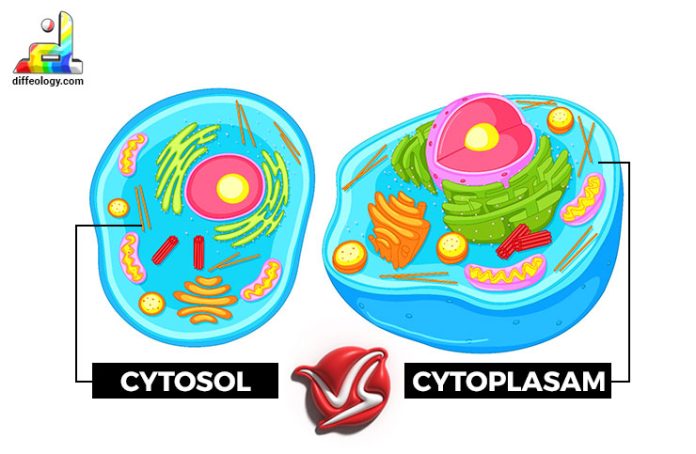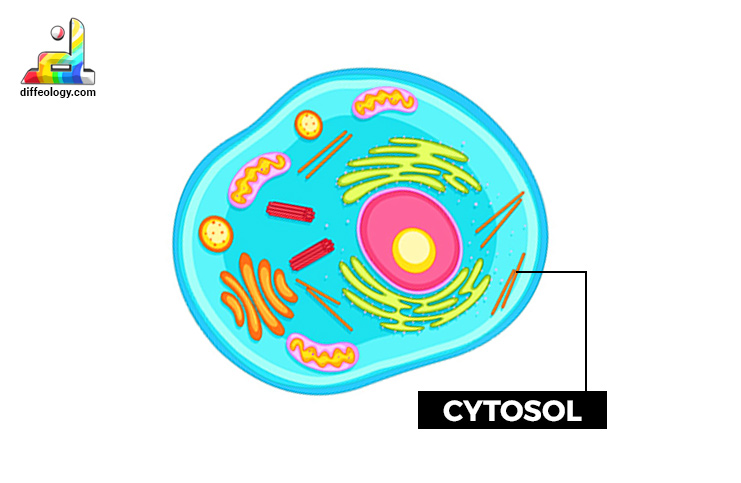Today, we will embark on an exciting journey to discover the amazing world that exists inside every cell. We will specifically explore two important components called the cytoplasm and cytosol. Get ready to dive into this fascinating microscopic world and learn the Difference Between Cytosol and Cytoplasm!
Before we delve into the details of cytoplasm and cytosol, let’s understand what a cell is. Cells are the building blocks of all living things, including plants, animals, and even us humans! They are tiny structures that work together to perform various functions that keep living organisms alive and healthy.
Main Difference Between Cytosol and Cytoplasm
Cytosol is like the watery juice inside a cell, while the cytoplasm is everything inside the cell except the nucleus. Cytosol is like the liquid part of the cytoplasm, and it surrounds all the tiny organs inside the cell. The cytoplasm is like a jelly that fills the cell and holds all the important stuff in place. Cytosol helps with cell activities and lets things move around inside the cell.
Cytoplasm is where all the action happens in the cell, with different organs doing their jobs. Cytosol is like clear water with tiny bits in it, and cytoplasm looks grainy because of all the tiny organs in it. The cytosol doesn’t include the cell’s control center, called the nucleus, but the cytoplasm wraps around the nucleus and goes all the way to the cell’s outer covering.
Comparison Table “Cytosol Vs. Cytoplasm”
| Composition: | The liquid part of the cell. | The whole substance inside the cell except for the nucleus. |
| Location: | Like the juice inside the cell. | Like the juice plus all the small parts inside. |
| Function: | Helps with chemical reactions. | Helps with chemical reactions, moving things, and holds organelles. |
| Organelles: | Does not have organelles. | Contains organelles like mitochondria, endoplasmic reticulum, etc. |
| Structure: | Clear and watery. | Grainy appearance due to small parts inside. |
| Nucleus: | Does not contain the nucleus. | Surrounds the nucleus and extends to the cell’s outer covering. |
Cytosol Vs. Cytoplasm
Now, we will show you the difference between Cytosol and Cytoplasm by describing each of them separately.
What’s in the Cytosol?
Cytosol, also known as the intracellular fluid, refers to the liquid component of the cytoplasm that surrounds the organelles within a cell. It is a clear, gel-like substance composed mostly of water, along with various dissolved molecules such as ions, proteins, sugars, and metabolic waste products.
Read Also: Difference Between Centrosome and Centriole
Cytosol serves as a medium for metabolic reactions, cellular transport, and the movement of organelles within the cell. It is also essential for preserving the cell’s shape and structure.
The Cytosol – The Watery Medium
Now that we understand the cytoplasm let’s zoom in on the cytosol. The cytosol is the fluid part of the cytoplasm, similar to the water in our soup. It is made up of mostly water and contains various molecules and ions that are essential for the cell’s survival.
What’s Inside the Cytoplasm?
Cytoplasm is like the jelly inside a cell. It fills up the space inside the cell and surrounds the nucleus and other important parts. It is made up of a clear gel-like substance called cytosol, which is like the watery part, and lots of tiny structures called organelles that float around in it. These organelles have special jobs to do, like making energy, packaging molecules, and helping with chemical reactions. Some important organelles you can find in the cytoplasm include:
- a) Mitochondria: These are like the powerhouses of the cell. They produce energy that the cell needs to perform its tasks.
- b) Endoplasmic Reticulum: It’s like a transportation system within the cell. It helps move proteins and other important molecules from one place to another.
- c) Golgi Apparatus: Think of it as a packaging and distribution center. It modifies and packages molecules and sends them to their correct destinations within and outside the cell.
All these organelles work together to keep the cell healthy and functioning properly. The cytoplasm acts as a medium for chemical reactions, supports the organelles, and helps molecules move around inside the cell.
The Cytoplasm – A Busy Environment
The cytoplasm is a jelly-like fluid that, like a watery soup, fills the whole cell. It is an essential part of the cell, holding many important structures within it. Think of the cytoplasm as a bustling city where different activities take place.
Difference Between Cytosol and Cytoplasm in Detail
The inside of a cell has different parts that help it function properly. One important part is called the cytosol, which is like a watery liquid. It contains many things like water, tiny molecules, and special proteins. These molecules are all mixed together in a special way that helps the cell do its job.
The cytosol is not alone in the cell. It has friends called cell organelles and inclusions. These friends are like small structures that help the cell with different tasks. They are also found inside the cytoplasm, which is a larger part of the cell that includes the cytosol, cell organelles, and inclusions.
Read Also: Difference Between Arteries and Veins
The cytoplasm is mostly made up of water, about 80% of it! There are other things, too, like nucleic acids, which are important for making proteins, enzymes that help with chemical reactions, lipids that make up cell membranes, and other small substances. The cytoplasm also contains salts and nutrients that are dissolved in water. This helps the cell absorb water easily.
One interesting thing about the cytoplasm is that it can conduct electricity. It’s like a pathway for electrical signals inside the cell. And because the cytoplasm is present throughout the cell, different materials can move around inside with the help of something called cytoplasmic streaming. It’s like a flowing river that helps things get to where they need to go.
So, think of the cytosol as a special liquid inside the cell. It has tiny molecules and proteins that help the cell work properly. And the cytoplasm is like a big area that includes the cytosol, cell organelles, and inclusions. It has water and many other substances that the cell needs. It can conduct electricity and helps things move around inside the cell.
Key Difference Between Cytosol and Cytoplasm
Now, see the key Difference Between Cytosol and Cytoplasm.
- Composition: Cytosol is the liquid part of the cell, while cytoplasm is the whole substance inside the cell except for the nucleus.
- Location: Cytosol is like the juice inside the cell, and cytoplasm is like the juice plus all the small parts inside.
- Function: Cytosol helps with important chemical reactions and moving things around in the cell. Cytoplasm does the same things and also holds all the small parts called organelles.
- Organelles: Cytosol is clear and watery, while cytoplasm looks a bit grainy because of the small parts inside.
- Structure: Cytosol doesn’t have any organelles, but it surrounds and interacts with them. Cytoplasm has lots of organelles like the mitochondria, endoplasmic reticulum, Golgi apparatus, and ribosomes.
- Nucleus: Cytosol doesn’t have a nucleus, which is like the cell’s control center. Cytoplasm surrounds the nucleus and goes all the way to the cell’s outer covering.
FAQs: Cytosol Vs. Cytoplasm
Conclusion:
You have now learned about the fascinating world of the cytoplasm and cytosol. Remember, these two components are vital for the proper functioning of cells, which in turn keeps all living organisms healthy and thriving. Keep exploring, and who knows what other secrets the microscopic world holds?
Cytosol refers specifically to the liquid component of the cytoplasm, while cytoplasm encompasses the entire substance filling the cell, including the cytosol and organelles. Cytosol serves as a medium for metabolic reactions and transport, while cytoplasm supports biochemical reactions, houses organelles, and enables molecule transport within the cell. We hope you now understand the Difference Between Cytosol and Cytoplasm.
References and External Links
- Cytosol Wikipedia. N.p.: Wikimedia Foundation, 26 Jan. 2017. Web. 6 Mar. 2017.
- Cytoplasm Wikipedia. N.p.: Wikimedia Foundation, 6 Mar. 2017. Web. 6 Mar. 2017.
- “Structural Biochemistry/Cell Organelles/Cytosol.” Wikipedia. N.p.: Wikimedia Foundation, 23 Oct. 2017. Web. 6 Mar. 2017.






